The Best of Riga: Things to Do, See, and Experience
Are you planning a trip to Riga, Latvia and wondering what makes this Baltic gem so unique?
I will forgive you for thinking that there isn’t much to do in Riga for I once thought so too… Little did I understand that whether you’re a history buff, an architecture enthusiast, or simply someone who loves uncovering new destinations, there really is something to discover for weeks!
There are also a few “must-see” tourist attractions that will make you wonder if it was worth the trek… and this guide will help you navigate the best sights the city has to offer.
As someone who has spent months wandering Riga’s streets (I don’t mean to make it sound like I’ve been on the street homeless, though), I’ve discovered everything from iconic landmarks like the Freedom Monument to hidden gems like Berg’s Bazaar.
I’m not writing just to give you a list of the places— I also wanted to give you my personal insights, practical tips, and even a few surprises to help you decide how you want to spend your time in Riga.
World Heritage Site in Riga
The Historic Centre of Riga is listed as one of three Latvian World Heritage Sites by UNESCO.
Where can you find it, you might wonder? Literally the entire city centre, including the Old Town and the so-called “Quiet Centre” is covered by the term “historic centre”!
Although you can find the plague on display in the Doma Laukums Square by the Dome Cathedral.
The Heart of the City: Riga’s Old Town
Visiting the Old Town
Let’s start with the most obvious tourist attraction in the city: the Old Town.
I feel like the Old Town of Riga is one big amusement park for tourists. This is probably true for many other cities like this too. You don’t see many locals, as the house prices are too expensive, and the only ones you do see are probably working there.
Having said that, there’s nothing wrong with it, quite the contrary! You can spend an hour or two just wandering the street and finding new, curious buildings around every corner. A word of warning though: the cobble-stoned streets are nice and authentic, but get very annoying very quickly.
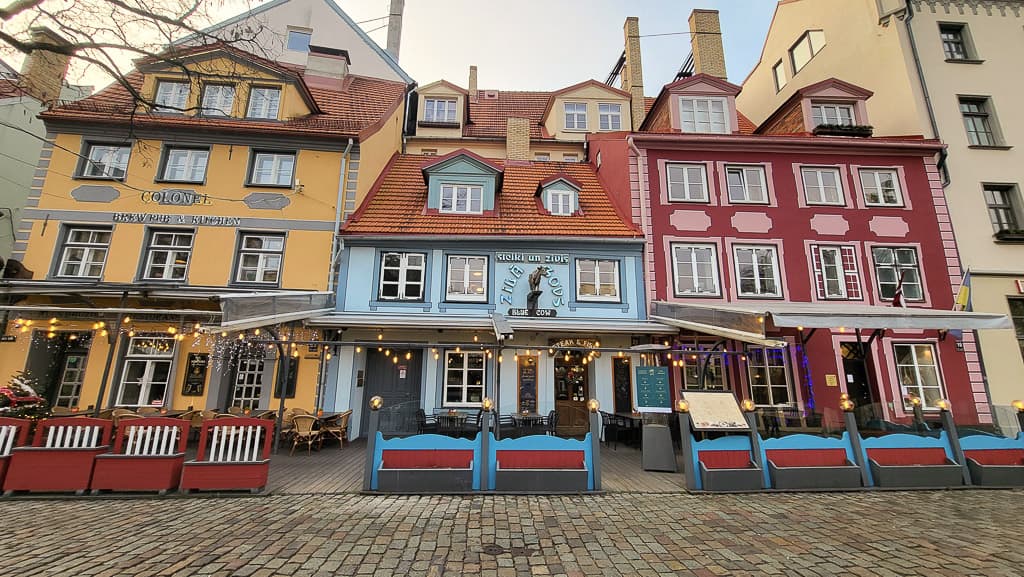
Restaurants and bars in the Old Town charge a premium, so everything will be more expensive here than on the “outside”.
Also having accommodation in this part of the city means that while very convenient, your accommodation is probably right next to a summer terrace, and/or if you’re lucky, you have live music until 6 am.
Just know that by staying here, you won’t get the full picture of the city. Most of the actual life happens in the so-called “quiet centre” of Riga, just north of the Freedom Monument.
House of Blackheads
The House of Blackheads (Melngalvju Nams) is one of Riga’s most iconic landmarks, known for its ornate Gothic architecture and striking colours. It was built in the 14th century for the Brotherhood of Blackheads, a guild for unmarried merchants.
The idea of a guild sounds posh, but once you learn that they used to host drinking parties where the doors were locked until the beer was all gone, you realise that they were just a bunch of single men. 😂 This is pretty well demonstrated if you go around to the left side of the building and take a peek at the carving on top of the smaller door.

The building was bombed to the ground in the wars, but has since been meticulously restored and now hosts exhibitions and cultural events, too.
You can enter the building for 7 €, but I recommend getting the ticket with sparkling wine or blackcurrant Black Balsam (only 2 € extra), going upstairs to the fancy ballrooms and pretending you’re taking part in a fancy ball! I totally felt like I suddenly had more money in my bank account.
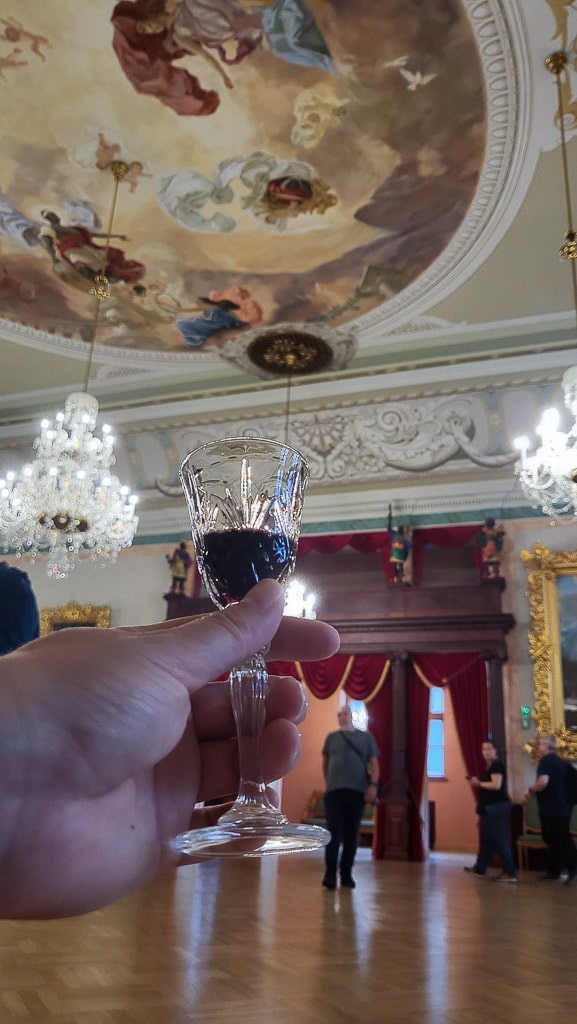
Town Hall Square
Town Hall Square is a lively part of the Old Town, surrounded by stunning architecture, including the House of Blackheads and the Town Hall itself. The square’s fountain (you can actually drink the water!) adds to the vibrant atmosphere.
When it’s not too cold, a lot of buskers come to play by the fountain. On my first day in Riga, someone was playing the cello and it sounded so beautiful in the surroundings!
The first ever decorated public Christmas tree stood on this square in 1510 (although Estonians disagree). There’s a small metal statue near the Blackheads’ House and the Museum of the Occupation for this occasion. Every winter, a huge real Christmas tree is decorated next to it.
In the summer you can find the instagrammable RIGA sign in the corner of this square!
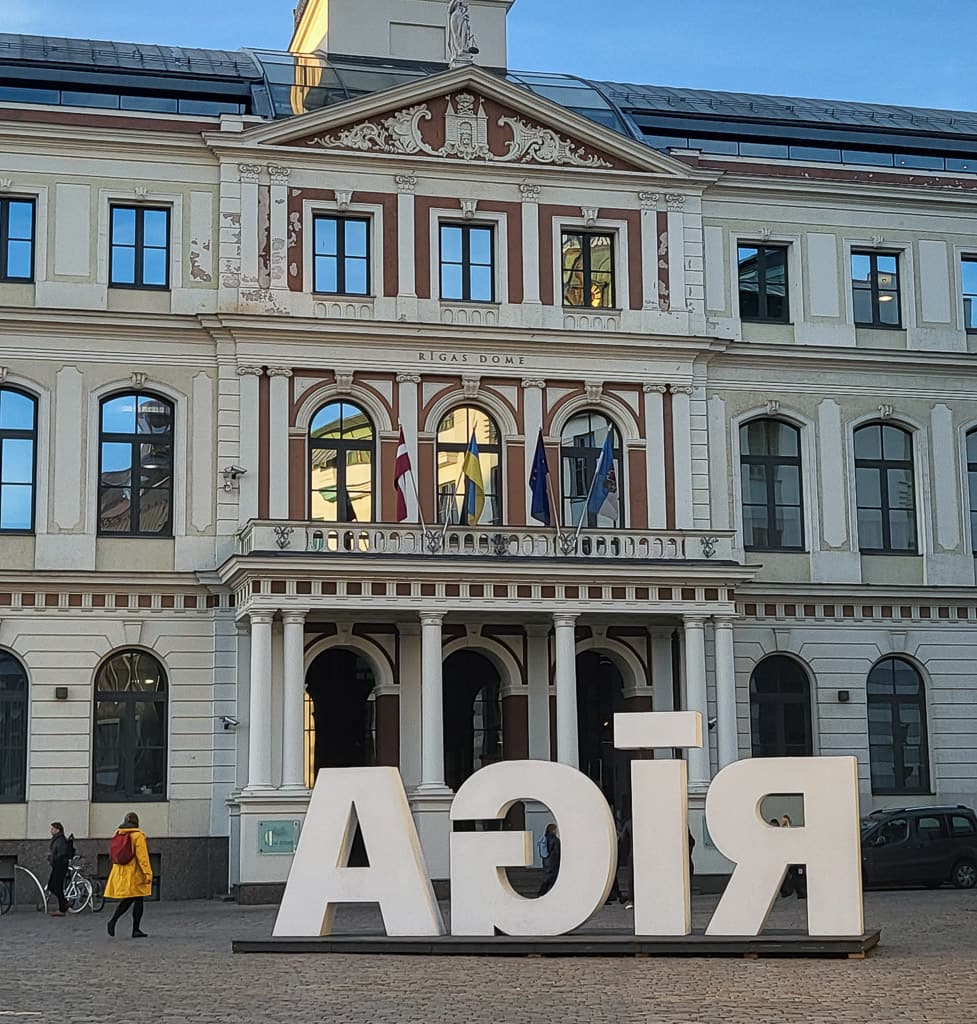
Town Musicians of Bremen
This statue can be found behind St. Peter’s church and was gifted to the city in 1990, when the country was still under Soviet rule. It’s a gift from the city of Bremen, and some say it’s a political statement on its own: some have interpreted that the musicians peek (or break!) through the Iron Curtain. The Brothers Grimm tale of the Town Musicians of Bremen can be viewed as a story about resilience and how you should never give up, so perhaps there’s a message to the Latvians there too.
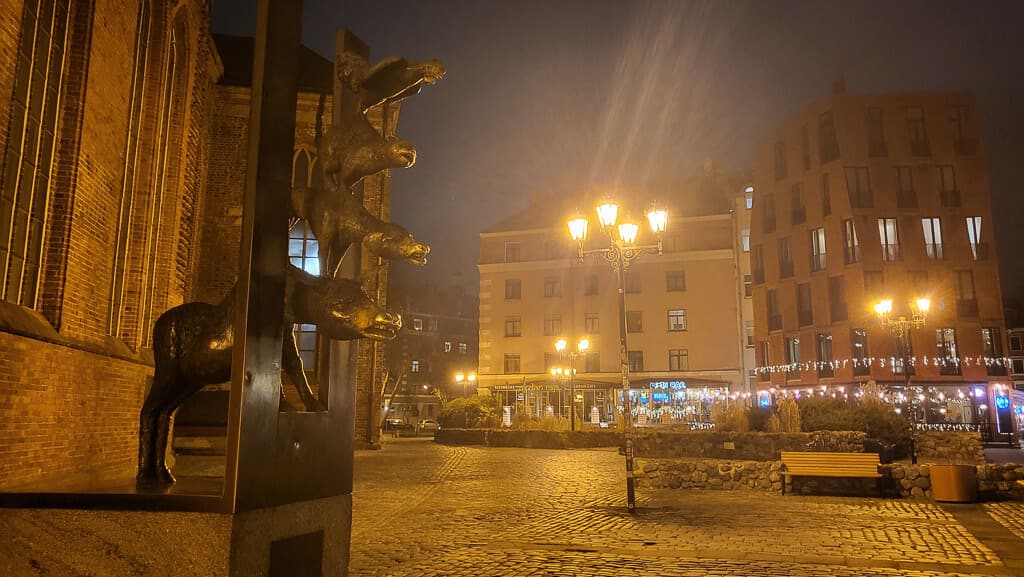
These days you can see how worn the noses of the animals are: it’s believed that rubbing the noses of the animals brings you good luck. Good luck trying to catch the highest one, though 😀
Cat House
Another of the more famous buildings in Riga is the Cat House (Kaķu nams), with two cats on the turrets.
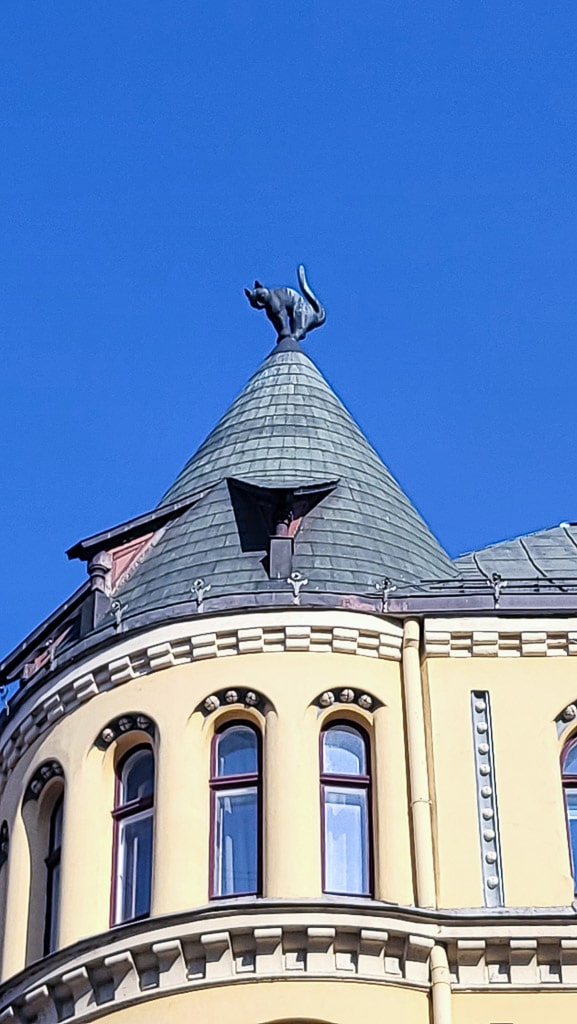
Apparently there are a few different legends, but the most amusing one is that a local merchant was not accepted into the Great Guild, so he went ahead and built a house next to it. To show his opinion on the Guild, he put up two cats on top, with their tails raised and ahem… backsides pointing at the Guild house. Just goes to show what you can do with a bit of money. 😂
The black cats have become a symbol for the city, but I can’t seem to find a definite reason for it: whether it’s this building or the many cats that allegedly wander around the city (I haven’t seen that many). In any case, you can find black cats everywhere in the souvenirs, be it magnets, mugs or towels.
Riga Castle
The Riga Castle is a symbol of power and history in Latvia, standing tall along the Daugava River. Originally built for the Livonian Order in the 14th century, it’s now the residence of the Latvian president and houses several museums (see below for National History Museum of Latvia).
Swedish Gate
The Swedish Gate is a beautifully preserved remnant of Riga’s medieval city walls and the only one of its kind still standing. Built in the late 17th century, it’s a picturesque spot with cobblestone streets.
The former city wall has been restored to housing and shops, and if you walk all the way to the end, you can see a beautiful mural of all of Latvian towns.
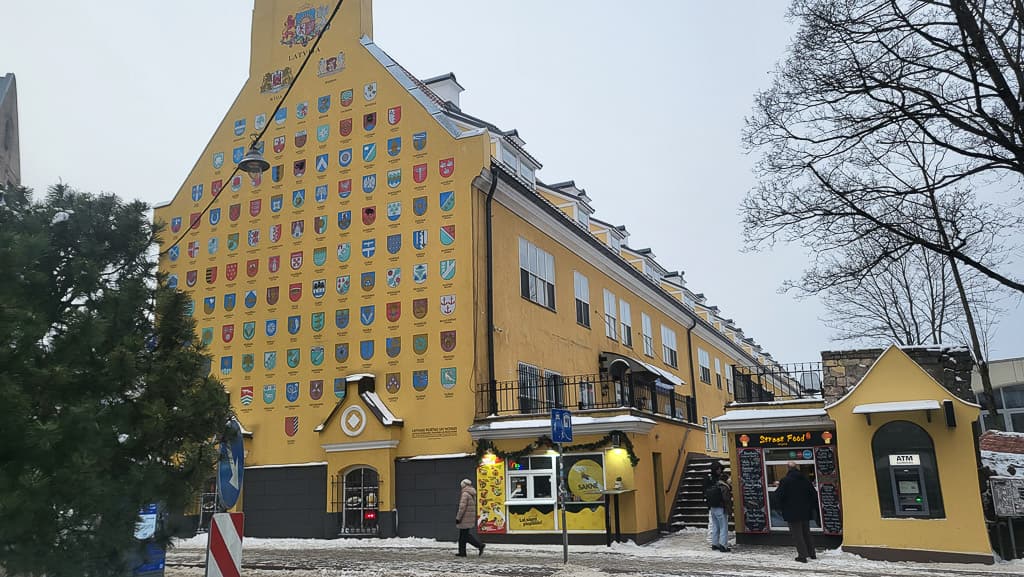
Freedom Monument
The Freedom Monument is a symbol for independent Latvia and it was built to commemorate all those who lost their lives fighting for freedom. You can find it separating the Old Town and Quiet Centre on Freedom Boulevard (Brīvības bulvāris), one of the main streets in Riga.
It’s pretty significant as it’s been standing in the same spot from the 1930s, even through the decades of different occupations. If you know how eager the Soviets were to get rid of anything that reminded people of their nationalistic tendencies, you realise that this is a down-right miracle.
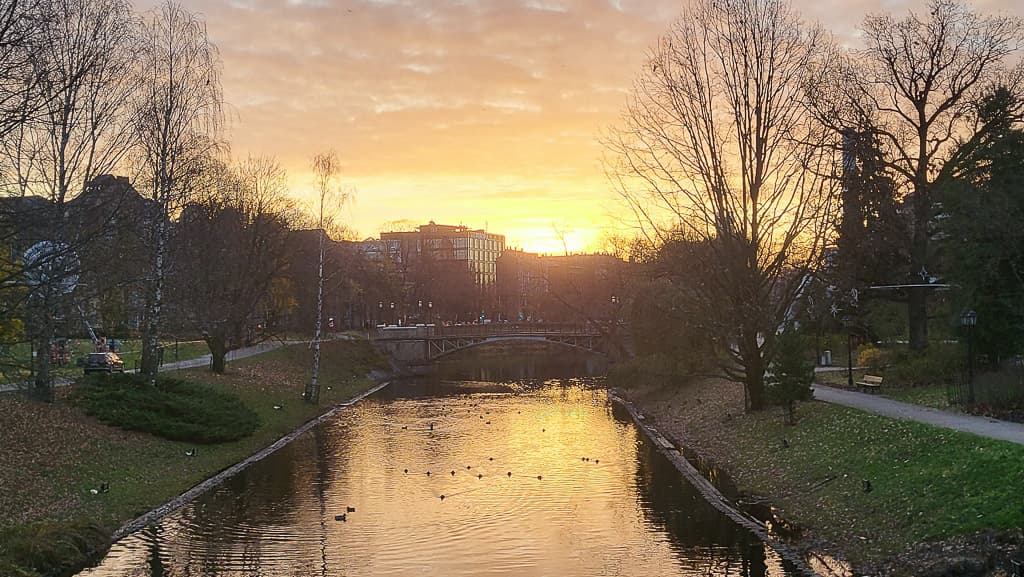
One of the reasons that this monument was able to survive was the fact that somebody somewhere convinced Moscow that the woman actually symbolises Mother Russia, with the three stars she’s holding being the three Baltic states.
It’s watched over by two honor guards, but they are not like the King’s Guard in London and I’ve never seen anyone take pictures with them. They are not allowed to interact with the public and it’s best not to disturb them at their work. There’s usually at least one other soldier standing off to the side plus two police officers patrolling the square and keeping an eye on the tourists – so make sure you behave respectfully! I believe the changing of the guard happens every hour. Although you won’t find the guards when the weather is too bad, or it’s too hot or cold.
The monument and the area surrounding it are a popular place for holding events. Every autumn when the new school year starts, students will march to the Freedom Monument for speeches and songs. During Independence Day in November, a stage is erected for speeches.
When you visit the Monument, be sure to hang out in the nearby parks surrounding the canal. It’s one of the nicest parts of Riga in my opinion, and the most romantic one in the winter!
Laima Clock
The Laima Clock near the Freedom Monument has been a beloved meeting spot for locals since 1924. It’s named after Latvia’s famous chocolate brand Laima (meaning “luck” or “beginning”). This is one of those tourist attractions that are listed everywhere as must-see, but you won’t miss much if you skip this one!
Other monuments and statues
I’m not sure what it is with Latvians and statues, but you can find them littered everywhere. Just stroll around the canal and there’s the Scottish (yup, you read that right) mayor of the city with his wife and dog, girls dancing in a circle, or a sombre looking guy that made me feel like I woke up on the Planet of the Apes at first!
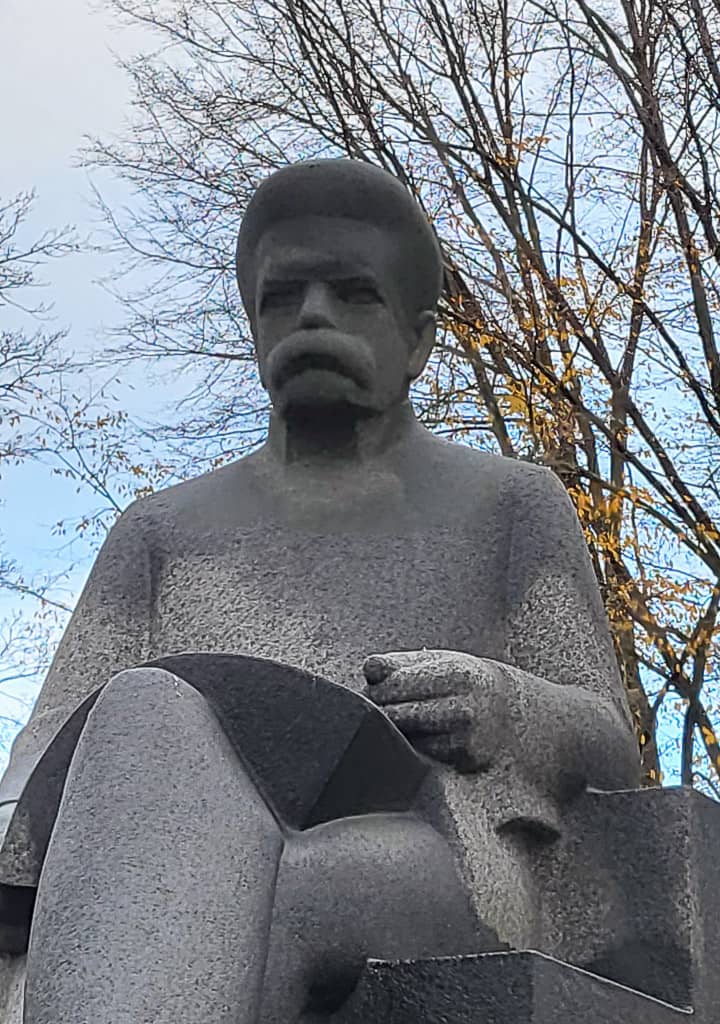
Riga’s Historical Treasures
The Multitude of Churches
It feels like there are about a hundred churches in Riga, you can see one no matter where you stand. I challenge you to cross the river, get a view of the city skyline, and try to count the church towers!
The most famous ones are Riga Nativity of Christ Orthodox Cathedral (beautiful, also has a skating rink next to it in the winter), St. Peter’s Church (has a viewing platform in the bell tower, you can enter for a fee), and Dome Cathedral (outside of which my favourite Christmas Market is held).
I’m not very big on churches, but these are the biggest and most beautiful ones in the Old Town or right next to it. They are great landmarks for navigating, just as long as you don’t get all the brown, brick churches confused with each other. 😀
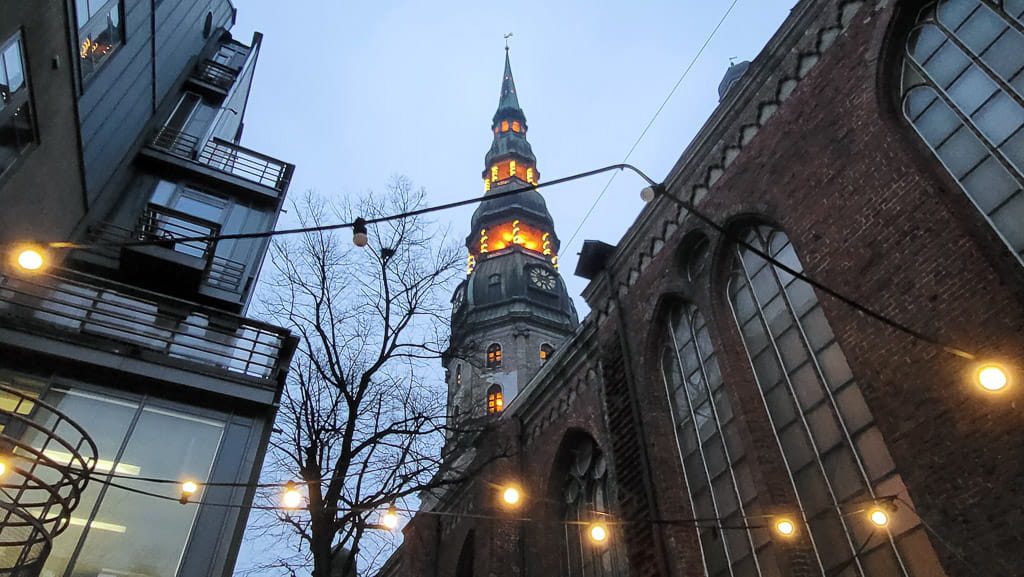
The Many, Many Museums of Riga
It feels like there’s a museum for everything and anything you can think of in Riga. I haven’t had the time or money to visit all of them (although I’ve visited some twice), but there’s so many that I decided to write a dedicated post just for them! There’s at least 15 listed, but I’m sure I’ve missed many more!
Cultural Outings
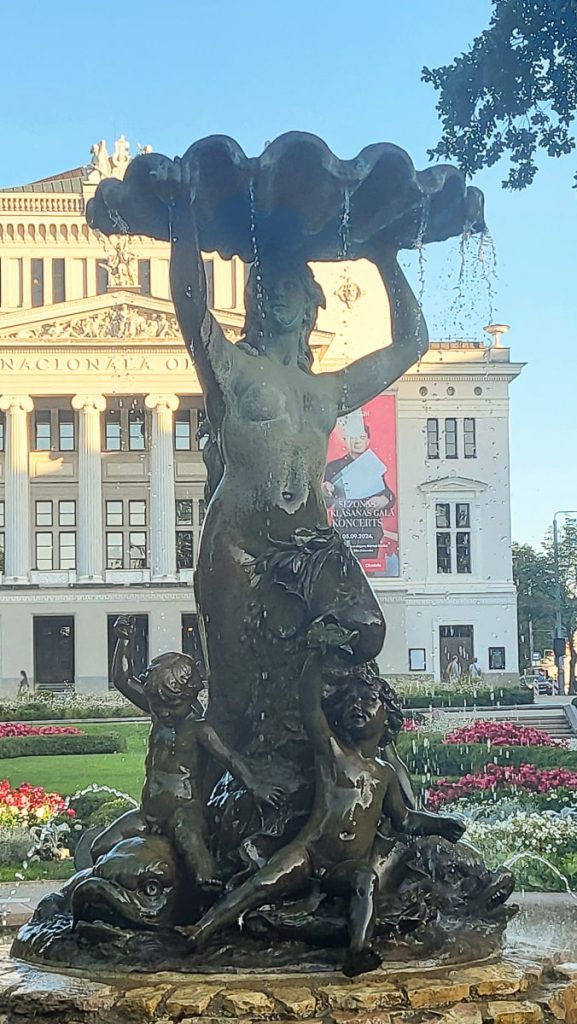
Latvian National Opera and Ballet
The Latvian National Opera and Ballet, often called Riga’s “White House,” is a historic venue celebrated for its world-class productions. It’s situated near the canal and surrounded by lush gardens, and is as beautiful on the outside as it is inside.
Attending a performance here is an unforgettable experience, and surprisingly affordable. I recommend checking their website well in advance, as the ballets especially are often sold out quickly!
Latvian National Theatre
The Latvian National Theatre is a (yet another) stunning building by the canal, but a bit of a walk away from the National Opera. The independence of Latvia was proclaimed here in 1918.
The performances are quite popular, and sold out in advance. They are also mostly in Latvian, but some performances have English subtitles via their app.
Tallinn Quarter
The Tallinn Quarter (Tallinas Ielas Kvartāls) is a huge outdoor party area with inner courtyards, concert halls and bars. When I visited in the summer, there was a silent disco going on: not particularly unique in itself, but with an outdoor space this expansive as your dance floor, it felt pretty spectacular! It’s definitely the go-to spot for the young and trendy crowd.
Check out their Facebook page to see what’s going on, or more information on this website.
Architectural Highlights
I’ve never been big on architecture, but coming here and seeing all these beautiful buildings everywhere has made me appreciate it a bit more.
Having been on one of the free walking tours that centered around art nouveau (or jugend style as it’s more commonly known in Northern Europe), I’ve come to realise that I don’t actually know all that much about architecture.
BUT! It doesn’t mean I can’t appreciate when I see something pretty, or otherwise thought-provoking.
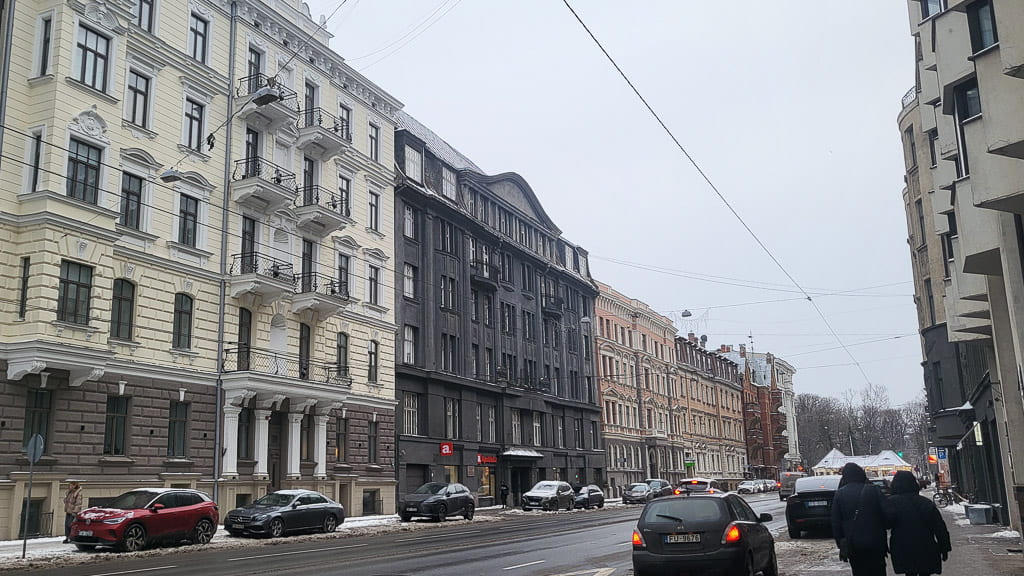
Art Nouveau district
When I say these are the best places to find nice art nouveau buildings, please don’t come at me if some of the buildings are not strictly art nouveau!
The most famous street is Alberta Iela (Albert’s Street), where rich Germans built their houses, only to have to abandon them when the World Wars started. The most famous building with the huge faces can be found around the middle of the street. The street was named after Bishop Albert, who is said to have founded the city (I would be more inclined to believe this story rather than the legend of the giant ferryman…).
You can also find the Riga Art Nouveau Centre (Rīgas Jūgendstila centrs) here. Ticket pricing depends on the season and what you want to see, so it’s best to check their official website for up to date prices.
A longer street, with most of the embassies and consulates, is Elizabetes Iela (Elisabeth’s Street). Along the street you can find magnificent buildings, and marvel at how much money these people had to spend on these buildings back in the day.
Take a bit of detour to the adjacent street called Ukrainas Neatkarības iela (freely translated as Ukrainian Independence Street). Walk to the end of the street to not miss the “art installations” locals have left around the Russian Embassy, in lieu of the country’s invasion of Ukraine. Funnily enough, if you search for this building in Google, a lot of the Russian sources will cite its address as “Antonijas iela”, refusing to acknowledge the official renaming of the street in 2022.
The Three Brothers
While the “Three Brothers” are often highlighted as a must-see in Riga, I have to admit I don’t understand what the fuss is about. They are undoubtedly historic and charming in their own way, but unless you’re planning to visit the Latvian Museum of Architecture inside, there isn’t much to do beyond a quick photo. If you happen to pass them on your walk around Old Town, you might even miss them..
That said, Riga is full of stunning architecture, with old and new buildings side by side throughout the city—many of which, in my opinion, are even more impressive than these.
Latvian Academy of Sciences
The Latvian Academy of Sciences is a standout piece of Soviet-era architecture, often nicknamed “Stalin’s Birthday Cake.” It was a gift from Stalin, and the only place in Latvia where you can see the infamous hammer and sickle, as the communist symbol is officially banned in the country. It is quite high up though, so you need to have good eyes!
Visitors can take an elevator to the observation deck for some of the best panoramic views of Riga, offering a unique perspective on the city.
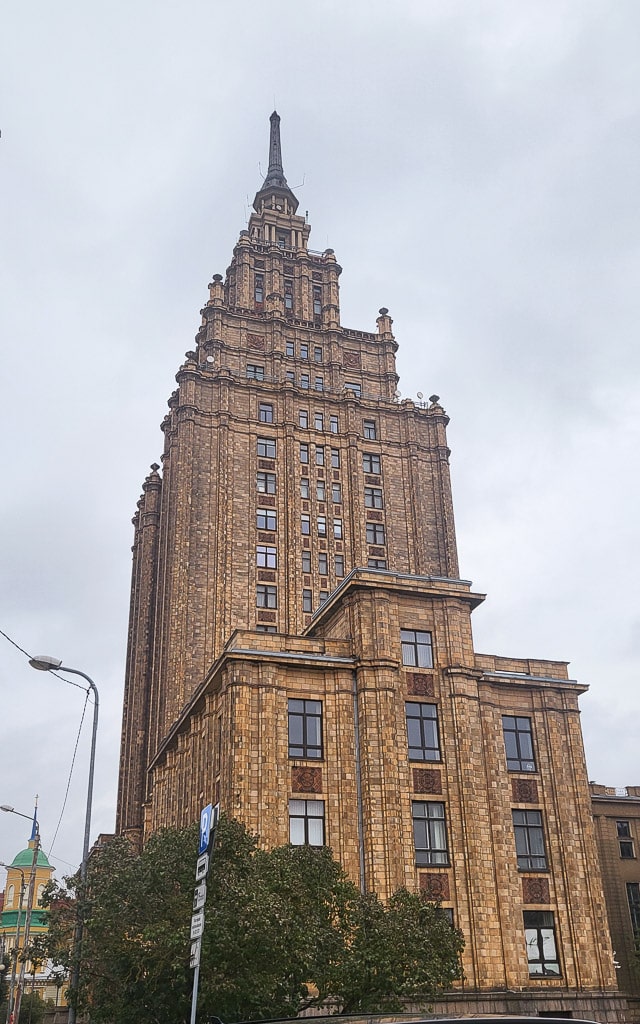
Exploring Riga’s Markets and Streets
Free walking tours
Best way to see the most important parts of the city, if you can spare some money, is to go on a free walking tour. (Free, because you don’t pay upfront, but not-free, because you’re expected to tip your guide at the end.) These are hosted by experienced guides, who are entertaining and bursting with knowledge.
I’ve been on four of the tours held by Riga Free Tours by now: Old Riga, Soviet, Alternative and Art Nouveau. I’ve been on tours with Ulrika, Mareks and Arturs, and can highly recommend any of them. You don’t get to pick your guide when you book your tour, but this is just to say that you don’t need to worry about the quality of the tour because all the guides I’ve seen are very professional! I usually have a lot of questions as I try to understand how things are connected, and they’ve been able to answer me.
Definitely catch one (or two, or all!) if you want a quick insight into the city.
Berg’s Bazaar
I accidentally stumbled upon this cute little “shopping centre” Berg’s Bazaar in the centre of Riga. It was evening, so most of the places were already closed, but I loved the atmosphere and vibe. It’s like a cosy little haven in the middle of the Quiet Centre.
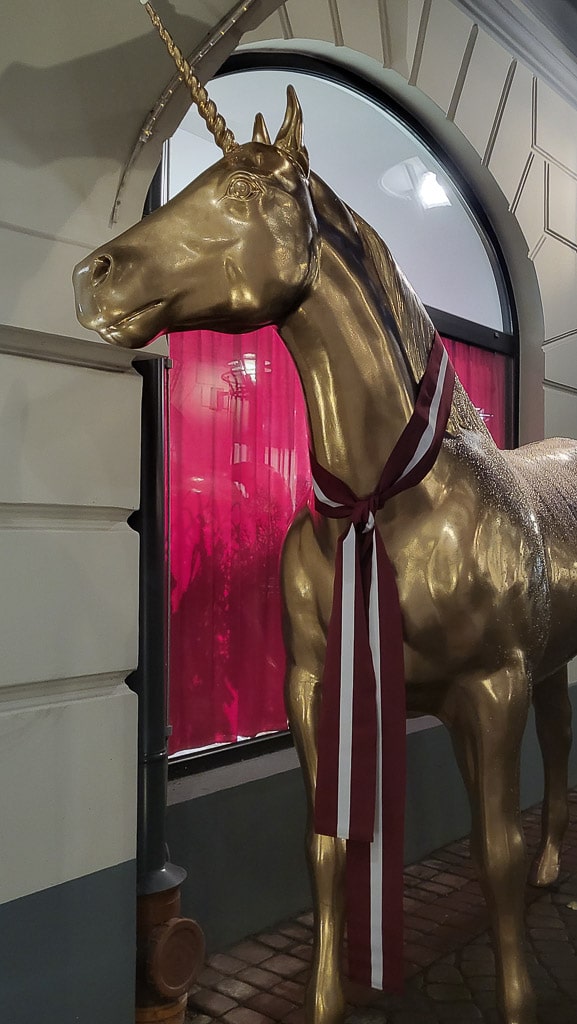
Central Market
Central Market is a must-visit, no matter what time of the year you visit Riga. I have spent 6 months in the city, and I love to see how the fresh produce changes depending on the season!
I love Riga’s Central Market so much that I wrote a dedicated blog post for it!
Just don’t make the same mistake that I did when I first visited: I entered the market from the train station side and only saw the meat pavilion – without realising that the outdoor market and the rest of the hangars are on the other side, I wasn’t much impressed. 😂I’m glad I went again and realised my mistake though.
Other shopping in Riga
Other, more modern shopping places close to the city centre are Origo in the train station, Galerija Centrs in Old Town and Galleria Riga.
Stroll Along River Daugava
One thing I loved to do in the summer and autumn evenings was to go on a stroll along the river Daugava. In the winter it’s usually quite windy, so I haven’t been around that much.
In the summer you can see the sightseeing boats drifting along the river, but I’ve been too scared of getting seasick to get on one. If you want to just soak in the atmosphere, there are benches along the promenade and in the late summer there might even be some huge hammocks placed on the green areas!
If you are lucky, you’ll be able to catch one of the big cruise ships that sometimes dock in Riga on their trip around the Baltic Sea. I don’t have too much experience in cruising as I haven’t been to any cruises outside of the Baltic Sea, but I can’t imagine the ports are right next to the city in most places! The ships look huge parked next to the buildings.
Lielais Kristaps (Big Christopher, or Christopher the Great)
A statue of the legendary founder (or a legend of a founder?) of Riga. The statue was erected in 1683, but now the original resides in the Museum of the History of Riga for protection: it is made from wood! The replica is protected by a building, but you can often see locals have left flowers around the base.
Crossing the river, you can get to Kipsala and the National Library.
Kipsala
An island and a neighbourhood in Riga, Kipsala is famous for its restored wooden houses. You can spend a few hours just wandering around the streets.
Here you can also find Lipke Memorial, a museum dedicated to Jānis (or Žanis) Lipke, a local man who saved the lives of 40 Jews during the Holocaust. I stumbled upon this museum by accident when exploring the streets of Kipsala, a fitting description of how hard it is to actually find this little museum as it’s tucked away at the end of a cul-de-sac. The museum is built next to Lipke’s family house, close to the original hideout that was never discovered by the Nazis.
One of the few beaches located in the City of Riga can be found in Kipsala as well. Just cross the Vanšu Bridge and you can see it on your right.
National Library of Latvia
If you cross the other bridge from the city centre, Akmens Tilts, you can find your way to the National Library of Latvia. It’s architecturally beautiful, although it took me months to realise that it’s suppose to present a book left open on a table.😀
Inside is the best part though: so pretty and you have a great view of the Old Town on the other side of the river. (Just don’t mind the spots on the windows…)
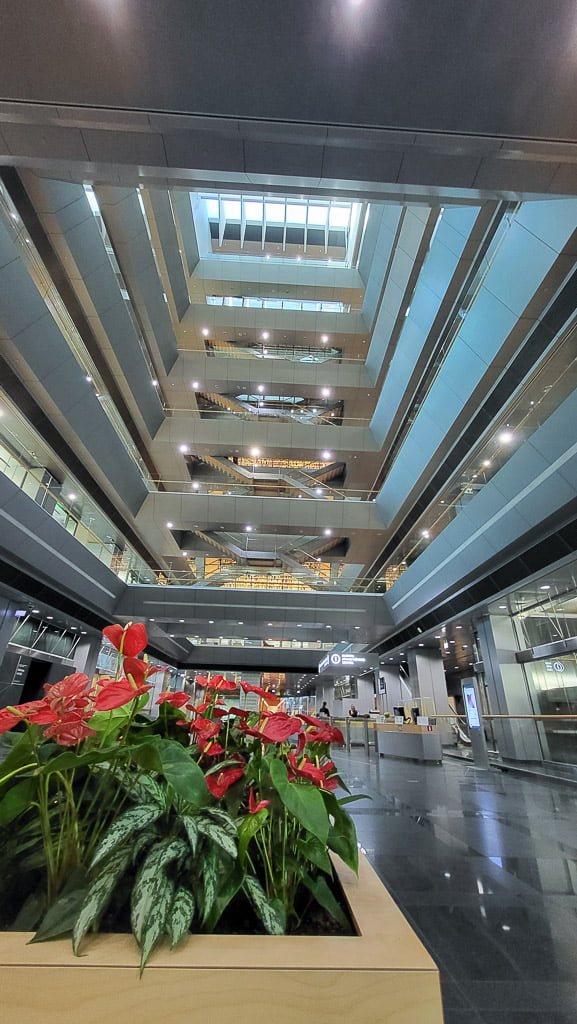
The admission is free, but you need to leave your jacket and bags in the lockers that operate on 1 euro coins (which I feel is fair enough, as it is a library after all, and they don’t want you stealing their books). You can bring your laptop with you, so it’s a great place to study or get some work done too.
Riga’s Ghetto & Museum
Just behind the Riga Central Market lies a neighborhood formerly known as the Moscow Suburb, though this name has fallen out of use since the Russian invasion of Ukraine. During the 1940s, this small area was tragically used by German Nazis to house Jews and has since been known as the Riga Ghetto. Today, the area has transformed into a hub for creativity and art.
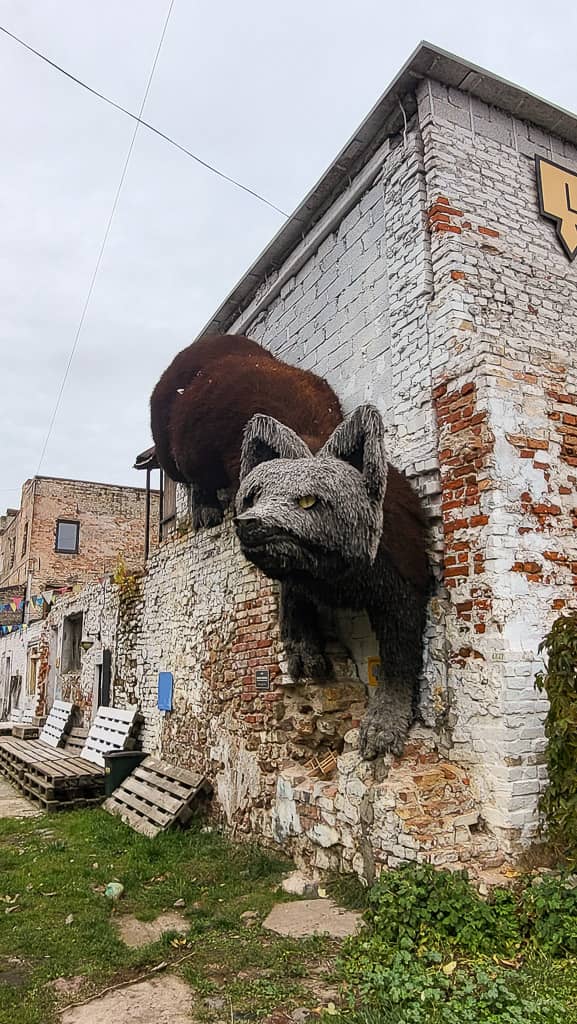
Within this neighborhood, you’ll find the Riga Ghetto and Holocaust in Latvia Museum. The museum offers a moving and educational experience, with admission based on donations. If you’re visiting in winter, be sure to dress warmly, as much of the exhibition is outdoors.
Catching Scenic Views of Riga
Latvia is a very flat country, and this is reflected in Riga as well: it is pretty much impossible to find any natural vantage points.
However, the city offers several spots where you can enjoy a bird’s-eye view and take in the skyline, most of which I’ve already mentioned:
- National Library of Latvia, on the southern bank of river Daugava
- St. Peter’s Church in the Old Town
- Latvian Academy of Sciences
I have a couple more places for you to try too:
Radisson Blu
Next to the Nativity of Christ Orthodox Church you can find one of the tallest buildings near Old Town: Radisson Blu hotel.
It’s a hotel (also known as Hotel Latvia) that was built in the 1970s, when the communist countries were opening up a little, so it hosted both Soviet tourists, as well as outsiders. Some of the features the hotel boasted were secret microphones in every single room, a KGB-handled telephone communication and a well-educated lady posted on each floor, just to keep an eye on you. As a visitor, you would be told that she is there to watch and report on you, and that you were not allowed to interact with her. She would report on when and with who you entered and exited the hotel. I learned this and many other interesting facts on the free walking tour “Soviet Riga Free Tour” by Riga Free Tours.
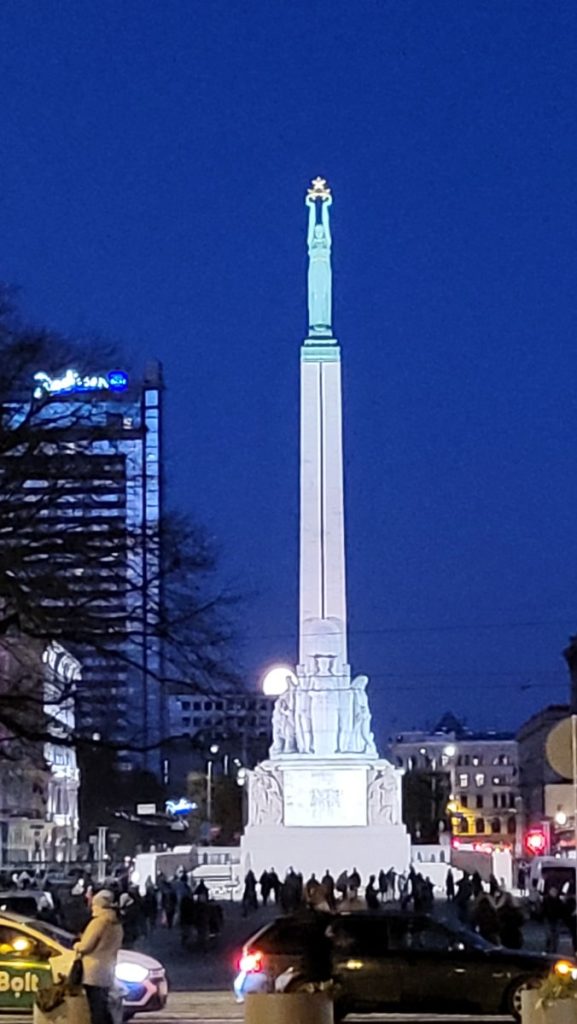
The reason I’m including a hotel on the list of things to see or do is not because it’s an amazing looking building (no it’s not) or I recommend it as a place to stay (I haven’t been, but I’m sure it’s nice), but because of the history and more importantly, the Skyline bar at the top! The bar is rather expensive compared to other places in Riga (but they do have nice cocktails that incorporate the famous Riga Black Balsam), but you just can’t beat the sunset views from this place! There’s a panoramic elevator that will take you up to the top floors, from where you can see the whole of Riga.
Rooftop terrace of Galleria Riga shopping centre
Galleria Riga is a popular shopping centre close to the Orthodox Church. Take the lift (the elevators are very confusing!) all the way up to the top or 8th floor to have a view of the city.
This viewpoint is not quite as high as the neighbouring Hotel Latvia, but on a nice summer evening the open roof-top terrace is such a nice place to chill!
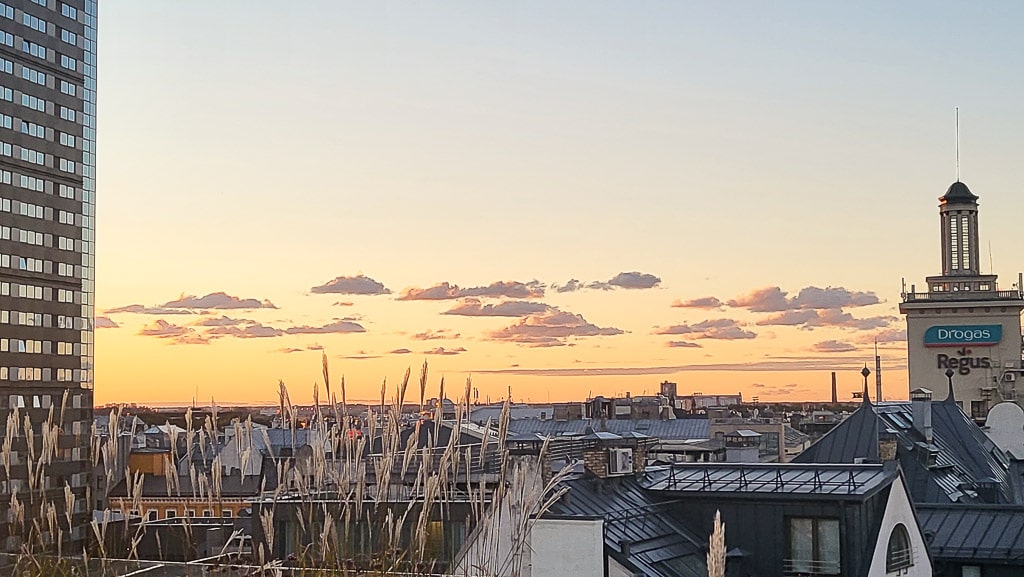
Why Riga Should Be on Your Travel List
Riga is one of those cities that really surprises you. Between its rich history, stunning architecture, and creative energy, there’s so much to see and do. If this post—with over 30 recommendations—hasn’t convinced you to visit yet, well, I’m not sure what will!
So if you’re planning a trip, take your time and enjoy everything this city has to offer!
Like it? Save it for later!
Want to do more research for your trip to Riga? Check out these posts:
- The Best of Riga: Things to Do, See, and Experience
- A Comprehensive Guide to Museums in Riga
- Why Riga Central Market Should Be on Your Travel Bucket List
- Your Winter Guide to Riga: Christmas Markets, Lights, and More
- Top 3 Hostels in Riga for Adults
- Riga Christmas Market: What to See, Eat, and Do
- Discovering the Best Coffee in Riga: A Surprising Twist
